The commander of the U.S. Pacific Fleet, Admiral Scott Swift, visited the Philippines this week and met with key government officials, the U.S. Embassy announced on June 14. His visit reaffirmed the continuing significance of the U.S.-Philippine alliance in spite of the setbacks that have been endured under President Rodrigo Duterte thus far.
The United States and Philippines have a long history of collaboration, but the environment for bilateral cooperation has been complicated since Duterte assumed the presidency last June. As I have noted before, Duterte has vowed to pursue a more independent foreign policy that diversifies Philippine alignments away from its traditional ally the United States and toward other major powers like China and Russia (See: “The Limits of Duterte’s US-China Rebalance”).
Duterte has also publicly criticized the U.S. military role in the Philippines and downgraded some U.S.-Philippine security cooperation (albeit not as sharply as his rhetoric initially suggested). This is despite the fact that the significance of U.S. assistance to Manila has been demonstrated lately in the military’s struggle against Islamist militants in the city of Marawi on the conflict-ridden southern island of Mindanao (See: “Where Are US-Philippine Defense Ties Under Duterte?”).
But as I have repeatedly stressed, the prospects for U.S.-Philippine defense ties are in fact brighter than Duterte’s personal sentiment might suggest. This is partly because his statements belie the deep institutional bonds between the U.S. and Philippine militaries and publics as well as the convergence of interests between the two nations in the face of common challenges, which include not just the South China Sea but also terrorism, piracy, and even counter-narcotics, which has been one of Duterte’s key focus areas (See: “The US-Philippine Alliance Under Duterte: A Path to Recalibration”).
The election of U.S. President Donald Trump last November has also offered an opportunity for a reset of sorts following a turbulent period under Barack Obama’s last few months. Trump has invited Duterte to the White House and committing to attending the ASEAN summit in Manila, where he will have a chance to meet the Philippine leader too (See: “Why Trump Should Go To APEC and EAS in Vietnam and the Philippines”).
In a sign of the activity still ongoing in the alliance, Swift visited the Philippines from June 11 to June 14. During his visit, Swift met with several Philippine officials, including Foreign Secretary Alan Peter Cayetano, Defense Secretary Delfin Lorenzana, Chief of Staff of the Armed Forces of the Philippines (AFP) Eduardo Ano, and Philippine Navy Flag Officer in-Command Ronald J.S. Mercado.
According to a press release issued by the U.S. Embassy in Manila, Swift “stressed the U.S. Pacific Fleet’s commitment to addressing shared regional security concerns including counterterrorism and piracy, while highlighting the strong defense ties between the U.S. and the Philippines.” The embassy added that Washington continued to support Manila in its efforts to strengthen national defense and improve its ability to respond to natural disasters, terrorism, piracy, and other transnational crimes.
Interestingly but not surprisingly, neither Swift’s own comments, which dwelled on the general outlines of bilateral cooperation as well as shared challenges between the two countries, or the U.S. embassy’s statement made any mention of the South China Sea. Though the dynamics were no doubt discussed privately, U.S. officials realize that public mention of the issue, which is a contentious, headline-grabbing one in the context of the U.S.-China relationship, would probably do more harm than good — particularly as Duterte believes the disputes are less of a practical concern to the Philippine people (See: “The Truth About Duterte’s ASEAN South China Sea Blow”).
Still, the contrast between Swift’s last visit to the Philippines and this one is nonetheless striking given his traditionally tough stance on the South China Sea. As I wrote previously during his inaugural trip to the region as Pacific Fleet chief back in July 2015, which included a stop in the Philippines, both allies did not just talk about the South China Sea, but Swift himself participated in a P-8A Poseidon surveillance flight over the disputed South China Sea (See: “US Commander Joins South China Sea Surveillance Flight”). The move was part of a firmer U.S. public campaign at the time to demonstrate that Chinese activities in the South China Sea would not undermine freedom of navigation and overflight (See: “The Case for a Bolder US South China Sea Policy”).

































